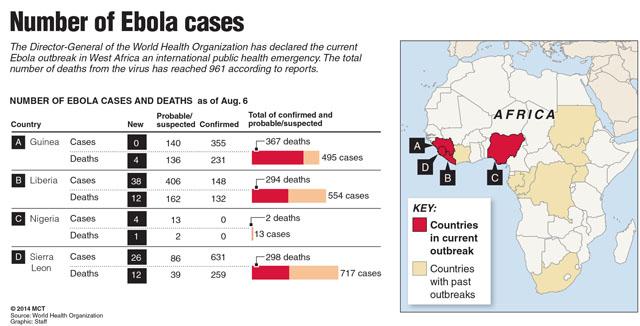You are here
Hiasat briefs Cabinet on measures to deal with Ebola
By JT - Aug 17,2014 - Last updated at Aug 17,2014

AMMAN — The Health Ministry has taken a set of measures in line with World Health Organisation (WHO) regulations to deal with any suspected Ebola case, Health Minister Ali Hiasat told the Cabinet on Sunday.
Noting that no Ebola cases have been detected in Jordan so far, Hiasat said all stakeholders in the healthcare sector have been provided with information on the virus infection's symptoms and how to deal with similar or suspected cases, the Jordan News Agency, Petra, reported.
Briefing the Cabinet on the Health Ministry's procedures, he said a system for early detection is in place, in addition to quarantine, monitoring and outbreak control measures, adding that Al Bashir Hospital is fully equipped to deal with any case.
Travel and civil aviation regulations have also been issued to deal with any potential infection, the minister said, according to Petra.
On August 8, WHO declared the epidemic that has claimed over 1,000 lives a global health crisis.
The virus emerged in Guinea in March and has since spread to Sierra Leone, Liberia and Nigeria. It has killed 1,145 people in West Africa, according to WHO figures cited by The Associated Press on Sunday.
Jordan peacekeeping forces serve in some of these African countries, but a Health Ministry official told The Jordan Times earlier this month that "they are very professional and know what to do in case of the outbreak of any disease."
Bashir Qasir, head of the ministry’s communicable diseases department, said there are health units affiliated with the Royal Medical Services with these forces and “they are experts in their field.”
Ebola virus disease (formerly known as Ebola haemorrhagic fever) is a severe, often fatal illness, with a case fatality rate of up to 90 per cent. It is one of the world’s most virulent diseases, according to the WHO website.
The infection is transmitted by direct contact with the blood, body fluids and tissues of infected animals or people.
During an outbreak, those at higher risk of infection are health workers, family members and others in close contact with sick people and deceased patients.
The severe acute viral illness is “often characterised by the sudden onset of fever, intense weakness, muscle pain, headache and sore throat”, according to WHO.
“This is followed by vomiting, diarrhoea, rash, impaired kidney and liver function, and in some cases, both internal and external bleeding,” the organisation said.
“People are infectious as long as their blood and secretions contain the virus... The incubation period, that is, the time interval from infection with the virus to onset of symptoms, is two to 21 days.”
Related Articles
The Health Ministry on Tuesday denied news reports claiming that an Ebola case was detected in the Kingdom.
Travellers entering Jordan from Liberia, Sierra Leone and Guinea, the three West African countries hit hardest by the deadliest Ebola outbreak in history, will be monitored and undergo necessary checkups at the airport, according to the Ministry of Health.
Although the Kingdom has not registered any case of the Ebola virus so far, health authorities are well prepared with a monitoring plan, a Health Ministry official said on Saturday.


















